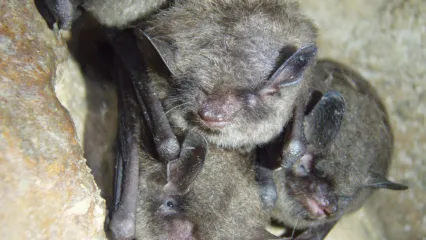
Description
The southern flying squirrel, Glaucomys volans, is one of the smallest Oklahoma squirrels. Actually, despite the name, the southern flying squirrel doesn't actually fly - it glides. The difference? Flying requires an unassisted gain in altitude, while gliding can be described as "descending with style." Regardless of the terminology, watching this squirrel travel from tree to tree is quite a treat!
These arboreal rodents are able to gracefully travel long distances by way of two adaptations. The first is its thin layer of fur-covered skin, or patagium, extending from the fore feet to the back feet. When stretched tight, this patagium acts as an umbrella, allowing the squirrel to glide through the air. The second adaptation is the flattened tail. Almost half of the total body length, the tail acts as a stabilizer and also helps when balancing on small limbs.
Although primarily gray with a cream colored stomach, there are reports of reddish brown flying squirrels. This small rodent weighs only three ounces at adulthood - slightly more than a regulation tennis ball. The only nocturnal member of the squirrel family, flying squirrels have large eyes that help them navigate in the dark, and a three to four-inch tail.
Due to the nocturnal lifestyle, little is known about the southern flying squirrel's distribution or conservation status, but recent research has shown that these squirrels have a larger Oklahoma distribution than previously known. Predators of the southern flying squirrel include birds of prey, snakes, and increasingly, domestic cats.
With a sharp eye and a little luck combined with a sightseeing or camping trip in Oklahoma's eastern deciduous forest, you may be able to catch a glimpse of the unique southern flying squirrel as it glides across the night sky.
Size
The southern flying squirrel measures only eight to 10 inches long - but its long distance flights of up to 200 feet make up for any shortcomings in size.
Habitat
Found in deciduous forests- primarily in stands of oak, hickory, or walnut - the southern flying squirrel is best known in the eastern half of the state. Even so, they have been recorded as far west as Comanche Co. in southwestern Oklahoma. These squirrels rely on fruit or nut producing trees for food and nesting habitat. Although nuts make up the bulk of the flying squirrels diet, they are one of the most omnivorous of squirrels- feeding on everything from flower blossoms to bird eggs. Another distinction between the flying squirrel and other tree squirrels is the feeding pattern. Flying squirrels cut a uniform circle on the side or end of each nut, leaving the shell intact. Other tree squirrels crush the shell to reach the meat.
Life Cycle
Southern flying squirrels are cavity nesters, using their nest throughout the year. These squirrels often use cavities that were originally excavated by woodpeckers, sometimes even causing woodpeckers to abandon the nest. Entrance holes to the squirrel nests are generally larger than one inch in diameter and the cavity is lined with bark and leaves. These rodents typically breed twice a year-once in late winter, and again in mid to late summer. The litter ranges from one to six, but often contains only two to three young, weighing only a quarter of an ounce each at birth. The nestlings are able to glide eight weeks later.


